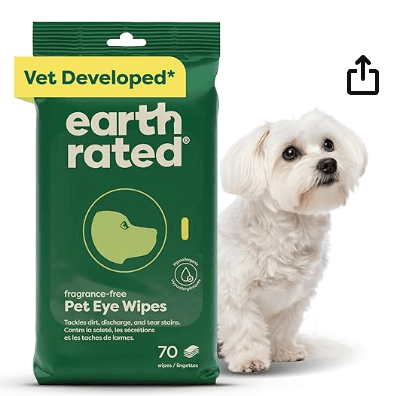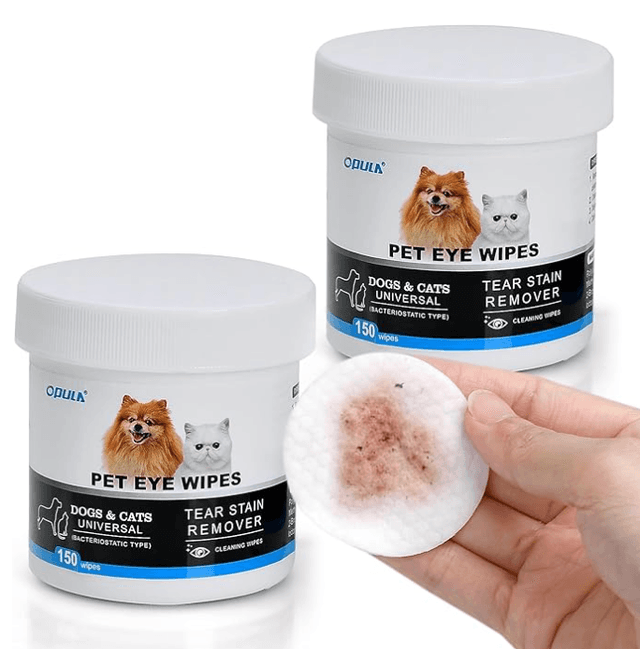Puppy Care Guide
Week 30 – Understanding and Managing Tear Stains (Epiphora)

Many pet parents notice brown or reddish stains forming around their puppy’s eyes. These tear stains, known as epiphora, result from excessive tearing and oxidation of compounds called porphyrins. Understanding the cause is key to keeping your puppy’s face fresh and healthy.
1️⃣ Why Tear Stains Occur
Tear stains appear when excess tears overflow from the eye. These tears contain porphyrin, a compound rich in iron that turns reddish-brown upon exposure to air and light — most visible on light-colored fur.
Occasional tearing is normal, but chronic staining often signals an underlying cause that should be identified and managed early.
2️⃣ Don’t Just Wipe the Tears — Find the Cause
Removing the stains alone won’t stop them from coming back. The key is to identify what’s causing the excessive tearing. Below are four of the most common reasons:
Cause 1. Food Allergies
Food allergies are a frequent cause of persistent tearing. If your puppy’s eyes are watery with no signs of infection, try switching to a new protein source (for example, from chicken to salmon or duck).
Improvement after diet change suggests an allergy-related issue. Vets can confirm this through a blood test (between $70 and $250).
💡 PetGo Tip: Treat ingredients can also cause allergic tearing. Avoid dairy, wheat, or chicken-based snacks for sensitive dogs.
Cause 2. Hair Irritation Around the Eyes
Overgrown facial hair can irritate the eyes, leading to excess tears. Use rounded-tip grooming scissors or visit a professional groomer to trim fur and prevent contact with the eyes.
Trimming regularly improves comfort, reduces tearing, and prevents infection.
Cause 3. Underlying Infections or Conditions
Eye discharge can also stem from bacterial infections, conjunctivitis, glaucoma, or even dental issues near the eyes.
If you notice redness, swelling, odor, or excessive tearing, consult your veterinarian for an eye check during your next visit.
Cause 4. Nasolacrimal Duct Obstruction (Blocked Tear Ducts)
Some breeds — especially Maltese, Poodles, and Shih Tzus — are prone to blocked tear ducts that prevent normal drainage. In severe cases, minor flushing or surgery under light anesthesia may be required.
👉 Discuss all options thoroughly with your vet before proceeding.
3️⃣ When to Seek Veterinary Help
While mild tear stains can often be managed at home, worsening or persistent tearing should be examined by a vet. If untreated, chronic moisture may lead to irritation or corneal ulcers.
Quick diagnosis ensures long-term comfort and prevents serious eye conditions.
🩺 PetGo Professional Care Tips
- Clean the eye area daily with a soft, damp cotton pad or pet wipes.
- Avoid human cosmetic wipes — they irritate sensitive skin.
- Keep fur dry to prevent bacterial growth.
- Provide a diet rich in omega-3 fatty acids and limited fillers for healthier eyes.
- Watch for signs like rubbing, pawing, or squinting — these indicate irritation or discomfort.
PetGo Shop | Eye Care Essentials
Keep your pup’s eyes clean, bright, and irritation-free. These gentle, vet-approved wipes help remove tear stains, dirt, and discharge — ideal for daily care and sensitive pets.

Earth Rated Pet Eye Wipes (70 Count)
Seller: Earth Rated
Fragrance-free, hypoallergenic wipes designed to gently remove dirt and discharge — keeping your dog’s eyes clean and clear.
$16.99
View on Amazon >
OPULA Tear Stain Remover Eye Wipes (300 Count)
Seller: OPULA
Extra-large, presoaked cotton pads that gently lift away buildup and tear stains — perfect for routine grooming of dogs and cats.
$23.99
View on Amazon >💡 In Summary
Tear stains aren’t just a cosmetic issue — they often reflect deeper causes like allergies, irritation, or duct blockage. Early care and consistent cleaning will keep your puppy bright-eyed, comfortable, and healthy.
Continue with PetGo’s Puppy Care Guide
PetGo helps you track your puppy’s wellness — from tear stains to happy, shining eyes.
© 2025 PetGo. All Rights Reserved
